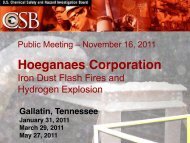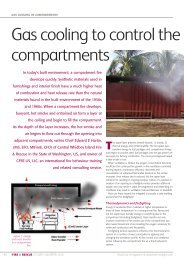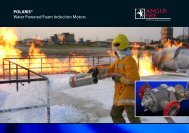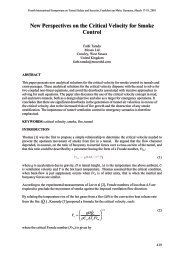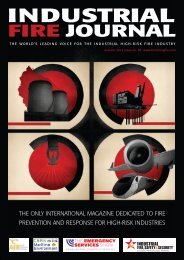fire protection of concrete structures exposed to fast fires
fire protection of concrete structures exposed to fast fires
fire protection of concrete structures exposed to fast fires
You also want an ePaper? Increase the reach of your titles
YUMPU automatically turns print PDFs into web optimized ePapers that Google loves.
Fourth International Symposium on Tunnel Safety and Security, Frankfurt am Main, Germany, March 17-19, 2010<br />
1400<br />
Modified HydroCarbon (HCM) <strong>fire</strong> curve<br />
1400<br />
Temperature (°C)<br />
1200<br />
1000<br />
800<br />
600<br />
400<br />
200<br />
0<br />
0 20 40 60 80 100 120 140 160 180 200<br />
Time (min)<br />
Temperature (°C)<br />
1200<br />
1000<br />
800<br />
600<br />
400<br />
200<br />
0<br />
0 2 4 6 8 10 12 14 16 18 20<br />
Time (min)<br />
Figure 5. Evolution <strong>of</strong> the inner furnace temperature under a HCM <strong>fire</strong> curve (on the right, focus on the 20 first<br />
minutes <strong>of</strong> <strong>fire</strong>).<br />
4. Results<br />
In this paragraph, the main results <strong>of</strong> the study are presented. Firstly, we present the analysis <strong>of</strong> the<br />
<strong>concrete</strong> spalling risk depending on different parameters (thermal <strong>protection</strong> thickness, type <strong>of</strong><br />
aggregates, mechanical loading). Then we present an experimental and numerical study attending <strong>to</strong><br />
establish the link between <strong>concrete</strong> spalling and the thermal gradients that is induced in the first<br />
centimetres <strong>of</strong> the <strong>fire</strong>d slab. At last, we present the results <strong>of</strong> the assessment <strong>of</strong> the residual<br />
compressive strength <strong>of</strong> <strong>concrete</strong> in the <strong>fire</strong>d slabs, from drilled cores.<br />
4.1 Concrete spalling<br />
The Table 3 summarizes the results <strong>of</strong> the maximal <strong>concrete</strong> spalling depths that were measured<br />
depending on different parameters such as the thickness <strong>of</strong> the thermal <strong>protection</strong>, the type <strong>of</strong><br />
aggregates and the type <strong>of</strong> mechanical loading. The main observations are as following.<br />
When <strong>concrete</strong> slabs are not thermally protected, <strong>concrete</strong> spalling occurs for any type <strong>of</strong> our tested<br />
<strong>concrete</strong>s (i.e. for both types <strong>of</strong> aggregates) and for any type <strong>of</strong> mechanical loading (i.e. with no<br />
loading or for compressive loading). In that case, <strong>concrete</strong> spalling involves the disappearance <strong>of</strong><br />
<strong>concrete</strong> cover and then the direct exposure <strong>to</strong> <strong>fire</strong> <strong>of</strong> the reinforcement.<br />
For the under sized thermal <strong>protection</strong> boards ( from 8 <strong>to</strong> 15 mm), <strong>concrete</strong> spalling can also occur.<br />
This has been particularly observed during loaded tests. It is very important <strong>to</strong> note that when <strong>concrete</strong><br />
spalling occurred for protected slabs, <strong>concrete</strong> spalling was deeper than for slabs with no <strong>protection</strong><br />
(see Figure 6). This unexpected result clearly indicates that an under sizing <strong>of</strong> the thermal <strong>protection</strong><br />
can involve an important damage <strong>of</strong> the <strong>concrete</strong> structure (with in particular an important exposure <strong>of</strong><br />
the reinforcement <strong>to</strong> <strong>fire</strong>).<br />
For thick enough thermal <strong>protection</strong> (20 and 25 mm in our study), <strong>concrete</strong> spalling is avoided in the<br />
case <strong>of</strong> loaded slabs. This results in a continuous <strong>protection</strong> <strong>of</strong> the reinforcement during the <strong>fire</strong> and<br />
good residual mechanical performances (see § 4.3).<br />
240



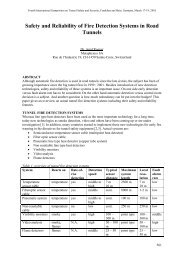
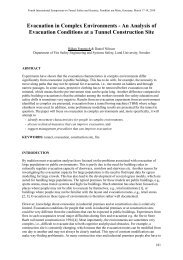
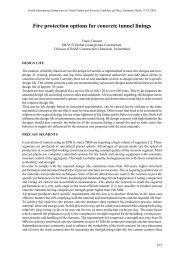
![30-37 TunnelsREV[1]rev.qxd - Industrial Fire Journal](https://img.yumpu.com/22237435/1/184x260/30-37-tunnelsrev1revqxd-industrial-fire-journal.jpg?quality=85)
